Author: Anna Kopachevsky
Scenes From the Latin Quarter, Rent, Opera Lecture
Something that I found to be interesting among the three is the different expressions of art and how they are each just as effective in communicating their message. I think that Scenes From The Latin Quarter and Rent have the most similarities in the way that they both discuss themes of love and poverty in connection to art. Personally, I enjoy it when people fuse love and art which I saw heavily in Patti Smith’s “Just Kids” so I found that I enjoyed Scenes From The Latin Quarter and Rent the most. Honestly, I was not a big fan of the Opera Lecture because as much as I appreciate the skill that goes into it, it is not something that fascinates me. The lecture did help me understand the evolution of Opera and how it came to be which I did like. For example, I liked the late 1880s style which dealt which romantic themes and “verismo” style. The transition of focus from monarchs and myths to common folk was what I enjoyed most because it delve into raw themes like passion, love, and lust. The example of Pavarotti was amazing and you can easily see the artist’s emotion. Even though I didn’t understand the lyrics, while reading the subtitles and observing his emotion I could feel what he was trying to portray in the opera. I liked Rent the most because I actually enjoy musicals and this was particularly interesting to watch. I really liked it because they had a song called “Seasons of Love” that I had no idea was from this movie so the entire time I was jamming out and knew the whole song. The movie overall had similar these to the book Scenes From The Latin Quarter because in the beginning they mention their inability to pay rent which was the same in the book and how they have to live off little. I also liked the shared bohemian theme, what I found admirable is that in Rent they stayed together despite their inability to pay rent and kept on producing art. There were a lot of raw topics like the AIDS crisis which allowed for a greater awareness for what was going on during their time. When Tom Collins and Angel both found out about their AIDS diagnosis it only deepened their bond. Throughout the movie their relationship was interesting to follow because it became my favorite couple as you can see their supportive relationship. When Angel died you could see the severe impact it had on Tom and the rest of the group which was a truly heartbreaking moment. This demonstrates the impact that AIDS had on the world and why it is so important to be aware of. Overall, my favorite was definitely Rent because its musical aspect which I thought fused different genres of art in one.
Punk Rock seminar
Although punk rock isn’t my favorite genre of music, Rich Stremme really made me appreciate its history and how it contributes to music today. I especially found it interesting when he brought up the contrast between British punk rock and US punk rock. He mentioned that British punk originated as a platform for working-class expression and a strike against the government, while American punk leaned towards edgy themes. He mentioned the two punk worlds often clashed and did not appreciate each other’s music. It was typical for British punk bands to have outrageous lyrics and most of them were considered working-class misfits. Another thing I found cool was the 7-inch records. The ones we got to see had very interesting covers and I think they were so shocking because it was unusual to see something like that nowadays. The zines were also fascinating which were magazines that would spread messages of punk rock. They weren’t a way to seek profit but rather a way of self-expression and identity. This reminded me of the modern zines we have now which just consists of social media. It was intriguing to hear about his experience in El Paso because it really showed me how widespread punk rock was. The fact that punk rock was able to connect people all over the world was so impressive. I also really appreciated the cute pins we got at the end as well as the stickers!!
Graffiti Art

“The Women Who Gave Birth to Rabbits” play
My trip started off a little rough considering I overslept and missed multiple buses. Luckily, I made it with some time to spare for Starbucks so it started out better than I assumed it would be.
It was just a simple reading so I honestly felt that I would not be impressed by the play. When reading it for the first time, it was so odd because there were moments where I wanted to stop reading as it got so twisted but during the reading, it was completely different. The fact that there were actors in front of me reading it brought an edge of emotion and life to the play it lacked before. Because to me reading words on a paper is simply just that, words on a paper. The actors had an excellent depiction of how I would have imagined the play to be produced. The screams of the women really grasped my attention and made me understand the raw emotion right in front of my face. The way that the actors made minimal movements and yet expressed so many emotions and feelings all at once was so impressive. I loved the comedic approach some actors decided to take and I liked to see each of their interpretations of the characters. Something that really stuck with me was when the playwright said that he did this play with a different group of people and they all had their own twists made me realize that this play and its characters can be seen in numerous perspectives. Overall, although it was the weirdest trip I have been on, it was cool to see.
Night @ the Museum
Going into the experience I was a little bummed that we had to go because it was late and in the middle of the week going into Brooklyn. However, I was surprised at the abundance of interesting and unique art that was shown in the museum. It was cool to see a lot of different pieces of art somehow work together.
Something that really struck me was the exhibit with all the chairs and interior design. It was odd because in the museums I have went to recently I haven’t really seen any objects shown in that manner.
One piece of art that I found to be interesting was The Great Deep by Frederick J. Waugh. Although it was a simple piece to intially look at it, it was captivating to see the depth in the painting. I found myself looking for a deeper meaning in the work of art. It is important to note the color choice in the painting as it uses deep blues and greens to establish a sense of the vastness of the world and its wonders. The stark contrast of the sky and water promotes the idea of admiration and fear all at once. This reveals an element of a persons vulnerability in the world as well as facing nature’s power. It pushes the viewer to understand that the ocean is full of secrets hence the areas of dark waters. It plays on the idea of the unknown and what it may suggest for people in their own lives. This work of art can represent so many things to different people such as the comfort or fear of the unknown, admiration of nature, or even appreciation for the opportunities yet to come.

Another art piece that I found intriguing was “Mrs Alexander Cumming” by John Singleton Copley. This art was similar to those we have analyzed in class so I think that played a major role in why I thought it was interesting. It says a lot about the way that art used to be portrayed and the audience that it was created for. I connected this work to John Berger’s book and how art was made for people of class and those who determined their worth based on art. It allows for the ideas of feminity and identity to be shown as the painter created the subject in a certain way, tailored to please the observer. However, if you look beyond that you can observe her demeanor and the way she carries herself even from a static image.
Overall, I had a pleasant experience because all macaulay students were together so we got to connect with the art together. This made the museum definitely less boring than my typical museum trips.
Visit to the Banksy
My trip to visit the museum was alright but the weather was not too great. I did end up going with friends since we went to Soho right after so it lightened the mood. I went into this museum with an open mind because it was fascinating that a graffiti artist could create impactful art.
This is actually my second time writing this blog because the first time the website crashed on me and nothing saved so… take two on my phone this time.

The first art piece at the Banksy Museum that caught my attention was one that was seen in Ukraine. This piece showed the reality of the situation in the war. The ordinary appearance of the woman as she is depicted to be in a bathrobe and the addition of the mask and extinguisher reveals the idea that Russia is intruding into the lives of ordinary people. Furthermore, it symbolizes the dangers faced by civilians and the need for safety amidst chaos. The fire extinguisher is an interesting pick for a tool because it can not be used as a weapon and yet it is an active response to the violence. I think it was interesting that Banksy choose to portray a woman rather than the typical man we see on the war scene. Furthermore, Banksy’s choice to create this piece in an area that was destroyed by the war reinforces the idea of street art as a form of protest. It brings global attention to local struggles, making the art itself a part of the dialogue surrounding war and peace.

The second art piece really drew my attention because I think it displays modern-day romance. It depicts two lovers that seemingly are close and yet they are so far. Their metaphorical distance shows the negative effect that technology has on the new generation and the way people interact. In the couple despite their the physical intimacy, they present to be emotionally distant, highlighting how technology can interfere with genuine connections. I think it displays that close proximity does not guarantee emotional intimacy. It pushes the audience to think on how technology might have effected their relationships so much so they might be oblivious to it. It pushes the agenda to “live in the moment” and that is something I really appreciate because I try to live by that. It reveals an element of distraction that phones bring where you can have everything in front of you but be too involved with the phone. In a world where communication is instantaneous and constant, the irony lies in how phones can foster a sense of isolation. This art piece really conveyed a powerful message that definitely targets younger generations.

This piece by Banksy spoke volumes, it connects to the idea that peace is absolutely necessary. It has a greater effect because the soldiers are the ones pushing for peace despite being fully armed. Although this art piece was curated in 2005, it is still just as relevant in as the world is amidst numerous wars where peace is vital. While society may celebrate military figures, the depiction of soldiers in a peaceful light can provoke discomfort, challenging people to reconcile these conflicting ideals. Further their depiction of being fully armed pushes the idea that they are the face of war and not the face of peace. This piece makes viewers think about the impact of war and its desperate need for peace. In our society today this should serve as a call to action to try to gain peace. It was also interesting to note the color choice which is a stark constant. The peace sign in red immediately drew my attention and the soldiers in muted colors made me wonder the significance of soldiers and not regular people. In general, I think this art piece had an important message that should not be taken lightly.
Visit to see The Counter play
My typical impression of small productions like these is often negative, as I do not particularly enjoy simple works. I would prefer a play like a Broadway show because I like it when there is more going on since I get distracted less. The trip getting to the city wasn’t bad, just a lot of traffic which is to be expected.
Walking into the theater, honestly, I was underwhelmed because I was skeptical about how such a small set could remain the set for the entire play. Even looking at the audience, I was certain that it was meant for a different audience than myself. I thought to myself that it surely couldn’t be as static and boring as it seems, in some aspects, I was proven right and very wrong in others.
When the play began, we were introduced to the two main actors: Katie and Paul. Katie works at a diner where Paul is a frequent visitor, and throughout the play, the dynamics of their relationship reveal itself. For the first of the play, I was unimpressed because their interactions seemed very mundane and too ordinary to become interesting. Honestly, I did not like the play until Paul asked Katie to become friends, this puzzled me because with a person who you see almost every day, I would assume they are already beyond acquaintances. After Paul established the two were friends, he revealed a deep secret that he was rather bored and depressed with the life he had led, and in the future, he wants Katie to poison him. This struck me. Such an ordinary play suddenly turned into a complex dynamic between the characters, and this now put Katie at a loss.
After the poison came into play, it allowed for both characters to open up and tell each other’s secrets. At this point, it became so interesting since Katie revealed her past love life and that she had 27 voicemails she could never bring herself to delete. Paul helped her through it. The connection between these two made me see each of them in different lights; it revealed that neither of them had a person who could help them with these tough decisions, they didn’t have a best friend. It showed me how such simple interactions at a diner could be so much more meaningful. The fact that there were only two characters in the play was so more impactful as it shows the quiet nature of the town and how their connection is so simple yet complex. It is insane that this little town, little diner, and ordinary people left such a message.
The play addresses such serious issues in a lighthearted way as a way to spread awareness. When Katie revealed that she could not have kids, that really hit me. I even felt bad for judging the play so quickly, saying it would not have an impact on me. But that twist explained so much about Katie’s hard exterior and soft inside persona. It made me think that people that we meet daily have things going on that we do not know of. Ordinary people have something going on that never reaches the surface. No matter how well you think you know someone, they have an untold story. It is a lesson to be conscious that you can’t tell everything about a person by looking at them or small interactions. It was such a small thing that left a huge impact on me.
The only thing I must note is that many of the references were outdated, at least for me. This confirmed my prediction it was aimed at an older audience. The one thing I liked was the connection to sharing the Netflix password it provided a humor that was easy to understand. However, even with the play geared toward an older audience, the message was still clear.
The use of lights and audio was something that was worthy to note as it added an element of movement in an otherwise static play. It was interesting that the progression of time was still easy to understand despite no direction. The simple light movement was crucial for supporting the play’s message.
The ending of the play was what I loved most about the play. The open-ended play posed so many questions: Did Katie poison him? Did Katie reunite with her old love? Did Paul continue his life in the town or move? It was such a meaningful ending. I loved the evolution of both characters, which was most seen at the end of the play. Katie is now able to open up just a little more and is able to rekindle her love with her past. Paul now sees the complexity of life, and how it is not always running away but simply moving forward, I hope he moves out of the town that he has stayed in most of his life.
Political art about Ukraine

This piece of political art stands for the conflict that is still ongoing in Ukraine. It depicts Vladimir Putin in an interesting point of view where he appears baby-like who is attempting to eat a dish that is just Ukraine. It is important to analyze this piece because it illustrates the strength and resilience of Ukraine. In the piece, there is the depiction of broken forks that show the amount of attempts that Putin had to divide Ukraine that have been unsuccessful. It is also important to note that this piece creates a distinction between a war between two countries and a war between a man and a country. This speaks volumes as it shows the unity in Ukraine as a country and a man with a dream of colonialism and destruction. It definitely still resonates now because although this piece was created in 2022, its message is still very much intact. Even two years later, Ukraine has very much stayed united and resisted every attempt illustrated in the artwork. The frustration on his face is very telling of his perspective on the war, as he is not reaching his goal. Even the subtle smear of red on his “bib” obviously demonstrates the bloodshed that has transpired. This piece does a great job of presenting its message without using any language. Overall, this piece is crucial in understanding the war and what is going on in both of the perspectives.
Trip to Whitney
My initial impression of museums has always been negative so this wasn’t much different. I thought this would be just as boring as the other museums I have visited. Even though my visit didn’t start as I planned, I was definitely pleasantly surprised. I actually planned to visit the Rubin as I heard good things about it and it was the most convenient to get to. Unfortunately, that visit ended up being very disappointing. When I arrived I was greeted with locked doors, I had no idea the museum was closed on Mondays. I did however take a picture of the outside so that was nice;) I ended up taking a bit of a detour to the Whitney, which actually took me by surprise how much I enjoyed it. Despite it being more modern art it had some great pieces.
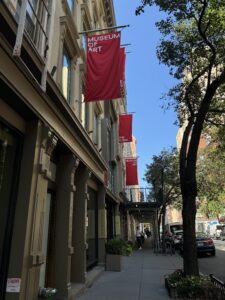
The first art piece that captured my attention was by Blythe Bohnen.
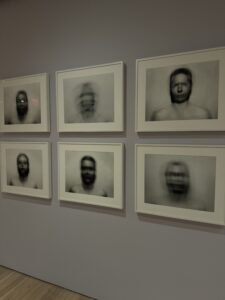
This was a unique piece that focused on the use of motion in order to capture a self portrait. It is strange because typically in a self portrait you are able to view every detail of the subject however this art piece is very up to interpretation. It portrays a moment in time that should show facial features of the subject but rather gives the viewers an unsettling and obstructed view of the portrait. There is no tell of who the person is but it feels like you can create a story based on the mere interpretation of their eyes. This piece pushes the viewer to imagine their own version of the self portrait as what is show is just a fraction of what it could be. Art is subjective, and just like John Berger believed, the camera can only capture so much in a moment of time. It made me understand that personal identity can be beyond a strict and motionless interpretation and rather a fluid and ever-evolving state. On the surface, I see a simple portrait, however upon further analysis I feel the complexity in the personality of the subject. The repetitive motion suggested to me the idea of cycles in life. Furthermore, the various phases of individuals lives that can’t be seen in a simple painting but this piece helped me see the complexity of the different phases of people’s lives which they continuously revisit and reinterpret with their identity. Overall, I was really drawn to this painting, however, it was odd since going in I had such a pessimistic view and the first painting already struck me.
The next art piece was by Edward Hopper.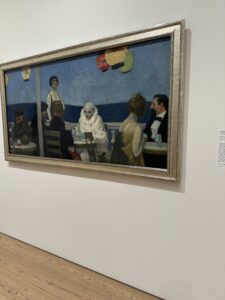
This painting was unique in its color. It was very bright and the strange addition of a clown drew me in. I was fascinated to learn what the original intent or the painting was because I had already made an interpretation on my own. The original purpose was an account of the artists experience in a Parisian art school where they combined numerous visits to different cafes and added their interpretation of the people around. To me, it touches on the divide in society today. Furthermore, the idea that there is always an outcast that sticks out like a sore thumb which is illustrated by the clown, while the people are clear critics for no apparent reason. It also touches on the idea of self awareness because how you see yourself may not always be the truth. The clown can portray that you are your worst enemy, and that not everyone is out to get you. It may always seem that you are the center of attention hence the portrayal of the clown in the center but it is foolish to think so. The piece made me feel a sense of coldness and isolation due to the high contrast of the colors. The calmer colors invoked a series of melancholy thoughts and contemplation that pushed a theme of emotional isolation which the subjects faces revealed. It seemed like even in a social setting everyone was so disconnected, much like the world today with advent of technology. Overall, there was nothing that I didn’t like in this piece, it was very complex and promoted deep thought.
The next piece was also by Edward Hopper.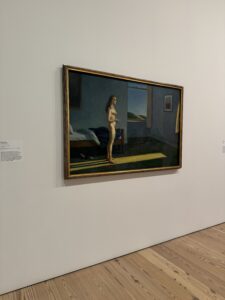
Initially, when I saw this painting, I walked right by it, however, upon second glance, I realize it was not much different than the paintings that we analyzed from John Berger’s book. I went back to see how the artist described this painting since much like the painting by Van Gogh that initially didn’t mean much without the words attached, this painting didn’t mean much without the words attached. After reading the purpose of the art piece it changed my perspective on it overall. The model in the painting was the artist’s wife who was 78 at the time of the creation of the work, however instead of painting, the realistic details, he created his everlasting idea of her from his memory. This open ended scene allows viewers to create a narrative of their own. This made me think of the quote from John Berger’s book about the difference of nakedness and nude. As the quote describes, you can be naked at all times, but it is only considered nude when you were viewed by others, I believe the artist wanted the viewers to understand the painting in that perspective. The use of light on the model pushes a theme of detachment from her environment which I interpreted as her careless persona. Yet I think this application of light does not idealize the woman’s isolation but rather exposes it. Her body language makes me think of a state of quiet contemplation and solitude. I feel like her nakedness goes beyond physical state but is also emotional and psychological all at once. To me, it felt like a raw depiction of a woman’s state and not one that is idealized.
The last piece of art was by Carmen Winant.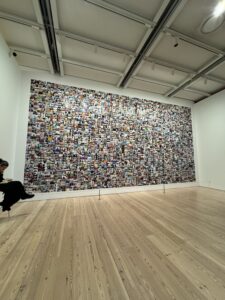
Although, I liked the message of the art piece it seemed too elementary to be considered art. Yes, the progression of the photographs was moving in the sense that it showed the evolution of the female reproductive rights but do I consider this art, no. Overall, this was not one of my favorite art pieces, the meaning was great but the portrayal not so much. There was no real deeper meaning that I could continue to analyze and that is something that I appreciate in most art pieces.
To conclude, my visit to The Whitney changed by view on most art museums as there can be art for everyone. Even though, museums are still not my favorite activity it is fun to analyze the deeper meaning of art pieces. I would visit the Whitney again with friends, I had a great time and all the exhibits were so unique.




